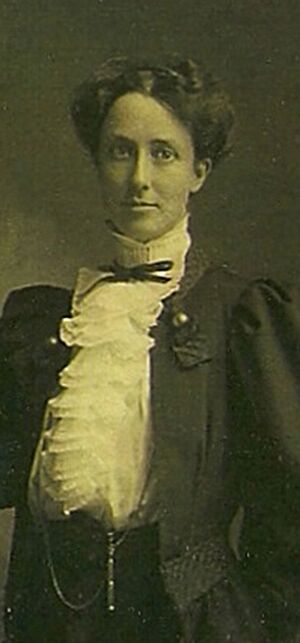Agnes Forbes Blackadder facts for kids
Quick facts for kids
Agnes Forbes Blackadder
|
|
|---|---|

Blackadder in 1894
|
|
| Born | 4 December 1875 Broughty Ferry, Dundee, Scotland
|
| Died | 12 May 1964 (aged 88) |
| Nationality | Scottish |
| Alma mater | University of St Andrews, University of Glasgow |
| Awards | Fellow of the Royal College of Physicians of Ireland |
| Scientific career | |
| Fields | Medicine (Dermatology, Radiography) |
Agnes Forbes Blackadder Savill (born December 4, 1875 – died May 12, 1964) was a Scottish doctor and medical expert. She made history as the first woman to graduate from the University of St Andrews in 1895. Agnes Blackadder was also one of the first female doctors to become a consultant at a major hospital that treated both men and women. During World War I, she used X-rays to help soldiers and was a pioneer in treating serious infections.
Contents
Agnes Blackadder's Early Life and Education
Agnes Blackadder was born in Broughty Ferry, Dundee, Scotland, on December 4, 1875. Her father, Robert Blackadder, was a well-known architect and engineer. Agnes grew up in Dundee and attended the High School of Dundee.
Becoming a University Pioneer
In 1895, Agnes achieved a major milestone. She earned her Master of Arts (M.A.) degree from the University of St Andrews. This made her the very first female graduate of that university.
She continued her studies at the University of Glasgow. There, she earned her medical degrees, including her M.D. (Doctor of Medicine) in 1901. During her time in Glasgow, Agnes was an excellent student. She won first prize in Practical Pathology and received top marks in many other medical subjects. In 1901, she married another doctor, Thomas Dixon Savill.
Agnes Blackadder's Medical Career
After finishing her studies, Agnes Blackadder moved to London. She became a specialist in skin diseases, known as a dermatologist. She also worked with electrotherapy, which uses electricity for medical treatment, and radiography, which involves X-rays.
A Leading Female Consultant
In 1904, Agnes became a member of the Royal College of Physicians of Ireland. She was appointed as a consultant at St. John's Hospital for Skin Diseases. This was a big step, as it was one of the first times a woman was appointed as a consultant at a hospital that wasn't just for women. She also worked at the South London Hospital for Women and Children.
Helping During World War I
During World War I, Agnes Blackadder played an important role. She worked as a radiographer at the Scottish Women's Hospital in Royaumont, France. She used a special X-ray car to help diagnose and treat soldiers.
Her work was especially helpful in understanding and treating gangrene, a serious infection. She would return to London when fighting slowed down, then go back to France when needed.
Music for Healing
While at the hospital in France, Agnes noticed something interesting. She brought a pianola (a type of player piano) to the hospital. She saw that both patients and staff felt better when they played or listened to music.
This experience inspired her to write a book called Music, Health and Character in 1923. The book talked about how important music is for well-being. Her ideas led to the creation of the Council for Music in Hospitals, which helps bring music to patients.
Post-War Contributions
After the war, Agnes Blackadder continued her medical practice in London. She also edited her husband's medical textbook, Savill's System of Clinical Medicine, completing it in 1942. Later in life, she developed an interest in ancient history. In 1955, she published a book about Alexander the Great.
Death and Legacy
Agnes Blackadder passed away in London on May 12, 1964. Her contributions to medicine and her pioneering spirit left a lasting impact.
In 2012, students at the University of St Andrews voted to honor her. They renamed a student residence hall Agnes Blackadder Hall. This hall was formerly known as New Hall. It was the first hall at St Andrews to be named after a woman, celebrating her historic achievement as the university's first female graduate.
See Also
- History of medicine
- Women in medicine
Images for kids


